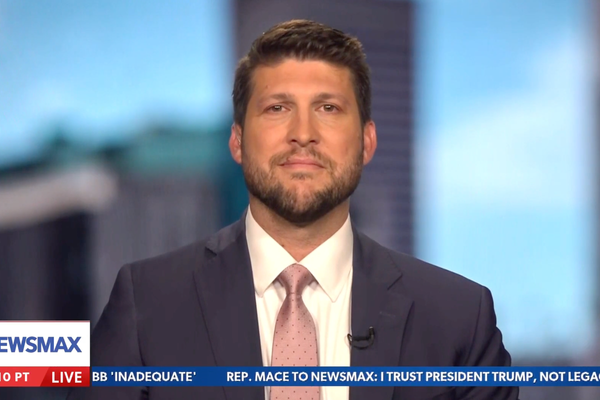While Wall Street recovers from its worst decline since 2022, many world markets across the oceans and in Latin America are sporting jealousy-inducing gains, eroding the once-dominant U.S. performance in global stocks.
Stock indexes in Germany, Poland, Spain, Brazil and other countries are up as much as 30% year to date. That's way better than the S&P 500 and Nasdaq, which are down about 1% and 3%, respectively, after rebounding several weeks. U.S.-based exchange traded funds that track those foreign markets are doing even better. Many are up more than 20% — and one is up 48% — as investors ask themselves, "How did that happen?"
The outperformance of world markets comes even as President Donald Trump's tariffs and trade war spread worry across many countries. The IMF cut its global growth outlook on April 22. (Over the weekend, the U.S. and China agreed to slash tariffs.) Yet investors are often finding much better alternatives in international stocks than on Wall Street.
And it's not just Trump's upending of global trade that's behind the shift. Strategists point to stock valuations (cheaper abroad), stimulus measures (in Germany in particular), plus some fortuitous trends for the yawning performance gap between world markets and U.S. stocks.
"After 10-plus years of the 'American exceptionalism' trade, global investors have very quickly rediscovered the value of geographic diversification," Nicholas Colas, cofounder of DataTrek Research, wrote in a note to clients April 23.
Overweighting U.S. stocks to some degree still makes sense because of disruptive U.S. innovation and other factors, Colas said in a later note. Yet today it's also risky to underweight foreign stock markets. The contrasting gap in monetary and fiscal policies in Europe and China vs. the U.S. "is too wide to ignore."
U.S. Stock Market Overvalued Vs. International Stocks
U.S. stocks had grown expensive in terms of valuation, and the rollout of tariffs caused the domestic market to roll over, says Jim Masturzo, chief investment officer for multi-asset strategies at Research Affiliates in Newport Beach, Calif. By comparison, Europe and emerging world markets remain more fairly valued even after this year's gains.
"We've seen this bifurcation between developed markets and the U.S., and a lot of that is investors recognizing that the U.S. was overvalued," Masturzo said.
Risk Management: How Invested In The Market Should You Be Right Now?
The investment advisory firm's long-term valuation model shows U.S. large-cap stocks with some of the priciest valuations among various global asset classes. Average nominal U.S. stock returns over the next 10 years are expected to be less than 4%, based on that model. In contrast, emerging markets, Europe and other developed countries show expected returns of around 8%-9%.
"South America from a valuation perspective is quite attractive," he added. Even Poland, which is up about 30% this year, still looks slightly cheap.
Currency trends also appear to work in foreign markets' favor. A strong dollar made it harder to invest in international stocks over the past decade, Masturzo said. But the WSJ Dollar Index is down about 6% this year. The greenback's fall has provided a tailwind for world markets, even before the tariffs shock.
ECB Is Easing, While Fed Is Stuck
Also, at a time when the Federal Reserve is reluctant to resume cutting interest rates, the European Central Bank has been steadily loosening for about nine months. That's provided a boost to European economies.
Around the middle of last year, Europe began to improve and look better vis-a-vis the U.S., says Michael Field, chief European market strategist at Morningstar. With inflation running at a more moderate pace than in the U.S., the ECB had more room to cut interest rates, which it did.
"And that paved the way for a better economic picture for Europe," Field explained.
Inflation is stable in Europe, but central banks are taking action, he added. ECB rates are now 2.25% and Bank of England rate are falling, albeit from a higher base. Europe's earnings season has gone generally well, although some firms refused to give full-year guidance due to economic uncertainty.
GDP expectations have shifted, too. Last year, the American economy grew at roughly twice the EU rate. This year, economists had expected EU GDP to grow 1.3% or 1.4%, a narrower gap with the 1.7% expected for the U.S., although these forecasts are now up in the air.
Meanwhile, as the Trump administration backs away from its NATO commitments, Germany and other European nations are raising their military spending.
Top World ETFs In 2025
| Symbol | Name | % Chg YTD |
| EPOL | iShares MSCI Poland ETF | 48.0 |
| EWO | iShares MSCI Austria ETF | 32.8 |
| EWP | iShares MSCI Spain ETF | 32.2 |
| ECH | iShares MSCI Chile ETF | 28.6 |
| EWG | iShares MSCI Germany ETF | 28.1 |
| EWI | iShares MSCI Italy ETF | 27.4 |
| EWW | iShares MSCI Mexico ETF | 24.1 |
| EWZ | iShares MSCI Brazil ETF | 22.4 |
| EWD | iShares MSCI Sweden ETF | 18.9 |
| EWL | iSh MSCI Switzerland | 16.6 |
| Data as of May 12 | ||
| Source: IBD MarketSurge |
"I think that the approval for military spending has been a major driver of European stock markets this year; military and defense stocks saw important inflows," Ipek Ozkardeskaya, senior analyst at Swissquote Bank, told IBD by email. "The tariff uncertainties have taken a toll on sentiment recently, but boosting military and infrastructure will likely fuel growth without fueling inflation at the same speed, giving the ECB margin to support."
The MSCI EMU Aerospace and Defense Index is up about 35% this year, according to FactSet.
Military spending among European members of NATO is expected to rise over $200 billion a year over the next five years, Elisa Mazen, head of global growth and portfolio manager at New York-based equity manager Clearbridge Investments, said in a report.
The earnings picture also is turning in Europe's favor, she added.
"In global asset allocators' search for the best risk-adjusted returns, the U.S. is no longer the only option," she wrote in a research paper. "We believe Europe now offers a better setup for earnings growth from depressed levels and scope for multiple expansion as more investors recognize the region's potential."
DAX Stock Market Index Rises
While there are multiple ways to measure market performance — country indexes, dollar- or local-currency gauges and ETF performance — ETFs provide the easiest way for U.S. investors to gain exposure to world markets. Many are concentrated in fewer of these international stocks that outperform their broader market indexes.
What are some of the best European ETFs?
While major indexes in London and Paris are up less than 7% year to date, Germany's DAX index is up 18%. Europe's largest economy got a 500 billion-euro stimulus (about $547 billion) March 18, when lawmakers approved a package of military and infrastructure spending.
Streamline Your Hunt For The Best Stocks
The iShares MSCI Germany ETF is up 28% and near new highs.
The ETF's major holdings include software developer SAP, with 16% of the fund's weighting. It also owns industrials Siemens and Rheinmetall plus financials Allianz and Deutsche Boerse. The U.S.-traded shares of those companies are at new highs, although the latter two solf off Monday. SAP broke out past a 280.44 buy point April 28. Siemens shares are consolidating.
Poland Stock Market Soars
Other winning international stocks can be found in Poland. IShares MSCI Poland has climbed more than 47% year to date. The WIG index is up around 30%.
Reports say this year's stock market rally has been driven by Poland's largest companies, including banks. The largest component of the ETF and WIG index is PKO Bank Polski, a consumer and business bank. Earnings per share are expected to climb 20% this year after a 69% jump in 2024, says FactSet.
The No. 2 Polish company is Orlen, a refiner that provides aviation fuel, heating fuels, natural gas, oils and other products such as petrochemicals. It also has a network of gas stations and provides electricity and heat distribution.
An important contributor to Poland's performance is technology. Poland is witnessing a surge in tech jobs. Earlier this year, Alphabet signed a deal to develop AI in Poland, where the company has its largest engineering hub, with more than 2,000 employees. Microsoft is also investing in Poland.
Spain, Italy Stock Markets Climb
Meanwhile, the iShares MSCI Spain ETF has climbed more than 32%. Spain's IBEX 35 index is up more than 17%.
For about two years, the Southern European economies have been the growth engine of the continent, Field says. Spain is at the forefront, while France and Germany have lagged. "With regard to Spain," Field said, "you had a pretty good performance from a lot of the companies within that index, and coupled with that the actual Spanish economy has been doing as well."
IShares MSCI Italy ETF is up 27% in 2025. The FTSE MBI index is up more than 15%.
Similar to Spain, the Italian economy has been strong, driving stocks. Some major banks have given the index a boost in 2025. Automaker Stellantis has been a drag on the Italian stock market, but for the most part, the good news has overcome the bad, Field notes.
Among other outperforming European stock markets:
- IShares MSCI Austria, up 33%. The ATX index is up about 20%.
- IShares MSCI Switzerland, up 16%. The SMI index is up 5%.
- IShares MSCI Sweden, up 19%. The OMX Stockholm 30 index is up less than 2%.
South American Stock Markets
Key Latin American stock markets also are outperforming the U.S. The iShares MSCI Brazil is up more than 22%. The Bovespa has gained 13%.
While Trump hit Brazil with a 10% blanket tariff, South America's largest economy is emerging a winner in the trade war. Brazil is rich in raw materials and commodities China needs, including beef, soybeans, iron ore and crude oil. Brazil is the biggest producer of footwear outside Asia. And Brazil could use tariffs to its own advantage by boosting exports to countries weighed down by tariffs.
The Brazil ETF is most heavily weighted in financials (nearly 38% of the portfolio). The single largest holding is Nu Holdings, a digital banking platform whose U.S.-traded shares are up about 25% this year.
Energy, materials, utilities and industrials make up 9% to 14% of the fund and figure to benefit from larger exports. The Bovespa index, by comparison, is 30.2% financials, according to FactSet. Materials comprise 14.3%, energy 11.6% and utilities 14.8%.
Mexico: A Softer Blow From Tariffs?
Other strong international stocks can be found south of the U.S. border. The iShares Mexico ETF is up 22% this year.
Mexico's IPC index has climbed about 13% year to date, but is still down from its peak in February 2024. The index plunged 6.1% June 3, 2024, after left-leaning parties won presidential and other elections.
By revenue, financials make up about 16% of the IPC, with materials, telecoms and industrials accounting for 11% to 16% each. The largest sector is consumer noncyclicals, at about 40% of the index.
Fomento Economico de Mexico, a bottler of Coca-Cola products, and bank Grupo Financiero Banorte are the largest components, each at more than 9% of the IPC.
Other stocks in the Mexico ETF and index include cement supplier Cemex, retailer Walmart de Mexico and wireless service provider America Movil.
Tariffs threaten a recession for Mexico's economy because one-third of the country's GDP is from exports, and around 80% go into the U.S., Jeffrey Kleintop, managing director and chief global investment strategist at Charles Schwab, said in a March 24 report.
Yet the impact on Mexican companies may be softened because Mexico's largest exports to the U.S. are goods produced by U.S. companies operating in Mexico, Kleintop added. Mexico's biggest exporters are automakers based in the U.S. In addition, a lot of Mexican companies have large operations inside the U.S., such as Cemex. Those goods would not be subject to tariffs.
Chile: Recovering Wages, Monetary Policy
Among other world markets to watch, the iShares MSCI Chile has rallied nearly 29% while the IPSA index is up nearly 24%.
In a January report, the Organization for Economic Co-operation and Development said Chile's growth recovered firmly in 2024 and this year's outlook remains positive. Falling inflation has allowed the central bank to continue its easing cycle, although the central bank has paused due to global uncertainty.
Chile came under the 10% reciprocal tariffs announced by the U.S. in April, although it argues a free-trade agreement between the two countries signed in 2004 justifies minimizing the levy. The Trump administration is also considering tariffs on copper, which has Chilean officials worried.
Chile is the world's largest copper producer and the main supplier of the strategic metal to the U.S. It is also a leading producer of lithium, critical to a broad array of batteries, including for electric vehicles.
Foreign Banks Shine In Some World Markets
Beyond ETFs, investors interested in international stocks might take a look at banks. While most world index ETFs are extended, some foreign bank stocks have formed bullish chart patterns and are outperforming.
Deutsche Bank shares are trading at the highest since October 2015 and are up for six straight months. The U.S.-traded shares are up more than 56% this year. Most of that came with a breakout to new highs on Jan. 14. Shares plunged in early April on tariff worries, but the stock has more than made up those losses.
The German bank on April 29 topped profit expectations as after-tax profit rose 39%. First quarter results put Deutsche Bank on track for its 2025 targets.
British bank Barclays is near new highs. On Feb. 13, Barclays said it expects to increase profits this year. U.K.-based NatWest Group broke out past a 12.65 buy point April 23. It owns a 98 Composite Rating, nearly the highest possible.
Spain's BBVA is up about 48% in 2025 and is trying to break out of a handle buy point at 14.43.
In India, Icici Bank and HDFC Bank broke out of cup-with-handle bases in April. Both are extended from buy points. HSBC is forming a cup base with a 61.88 buy point. Icici has a 94 EPS Rating, the highest of 26 stocks in IBD's foreign banks group.
Brazil-based Itau broke out of a cup-with-handle base April 22 and is extended from the 5.80 entry. Peru's Creditcorp is breaking out past 200. Both have Composite Ratings in the 90s.
Other World Markets: What About China Stocks?
Even China — the main target of U.S. tariffs and trade hostility — is outperforming Wall Street this year.
The Hong Kong-based Hang Seng Index is up 17.4% year to date, while the Shanghai Composite is up 0.5%, still beating the S&P 500. China-focused ETFs such as Krane CSI China Internet are up more than 17% after Monday's gains.
Swissquote's Ozkardeskaya has written that the DeepSeek artificial intelligence boom has given Chinese equities a boost this year. China can boast Big Tech names with a proven track record for building game-changing technology, such as Alibaba and Tencent. And Chinese consumers tend to adopt new technologies quickly, allowing advances to spread fast.
"Does that counterweigh the political, geopolitical and trade risks? Time will tell," she added.
Trump singled out China for tariff retaliation, raising levies to 145% before talks led to a truce. Faced with economic costs, Chinese policymakers have stimulus tools available. Already, the People's Bank of China had allowing the yuan to depreciate to its weakest level against the U.S. dollar in more than a decade, Morningstar international economist Grant Slade said in an April 10 report. That helps offset the impact of the trade war on China's economy.
As International Stocks Rise, U.S. Exceptionalism Falters
This year's Wall Street struggles come after more than a decade in which U.S. investors were spoiled with better returns than just about anywhere on the planet. Historically, the U.S. stock market outperforms the rest of the world, based on multiple gauges.
In fact, every rolling 10-year period since 2013 has favored the U.S. stock market over international stocks, State Street Global Advisors said in a November report.
- U.S. stocks have beaten all other G6 nations over every rolling 10-year period since 2015.
- U.S. small caps have outperformed foreign small caps in every 10-year rolling period since 2013. This means it wasn't just megacap firms that drove U.S. returns.
- Both U.S. value and growth stocks have outperformed non-U.S. gauges during every rolling 10-year period since 2010.
International Stocks In Emerging Markets
The results haven't been much better for emerging markets.
According to DataTrek Research, the MSCI Emerging Markets equity index has, on average, underperformed the S&P 500 by 3.8 percentage points in any given 100-day period since the start of 2015.
Five times in that 10-year period, the emerging markets benchmark outperformed the S&P 500 by two standard deviations. Each time, emerging markets went on to underperform U.S. large caps by an average of 5.7 percentage points, says analyst Colas. At the time of the April 23 report, the emerging market index was almost at that threshold.
China, which accounts for 29% of the MSCI Emerging Markets index, also is beating Wall Street at a pace where it's likely to start lagging the U.S., Colas says.
MSCI China has, on average, underperformed the S&P 500 by 3.4 percentage points over any given 100-day holding period since 2015.
While the data suggest it's time to underweight emerging markets and China, Colas says China must provide stimulus to its economy to get through potentially lengthy trade tensions. "Global trade policy uncertainty is unlike anything global markets have seen in the last decade," Colas said. "Historical return bands may therefore not be as reliable as under more comparable conditions."
Forecast For World Markets
Can foreign stock markets keep outperforming the U.S.? Economists and analysts believe the ever-shifting narrative around tariffs makes it difficult to forecast performance. Most who shared their outlooks with IBD said risk remains in world markets.
"Stepping back from the day-to-day volatility for a minute, this is simply an extraordinary moment. We will look back years from now and realize this was a transformational moment when geopolitics, trade, global security accords and accelerated de-globalization all collided at once, resetting the global order," Darrell Cronk, president of Wells Fargo Investment Institute and chief investment officer at the bank's Wealth & Investment Management division, said.
"Is it any wonder that financial markets are serving as the real-time transmission mechanism for these events?"







